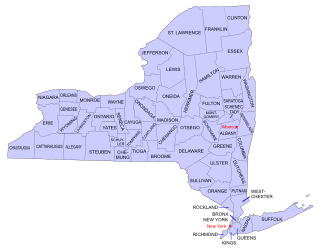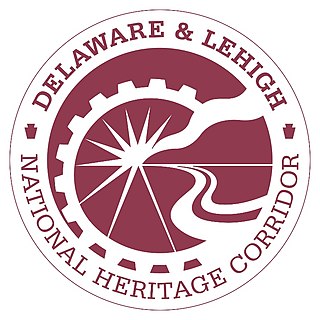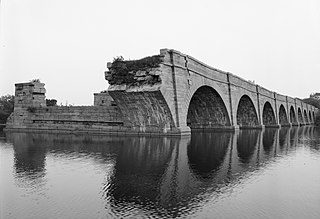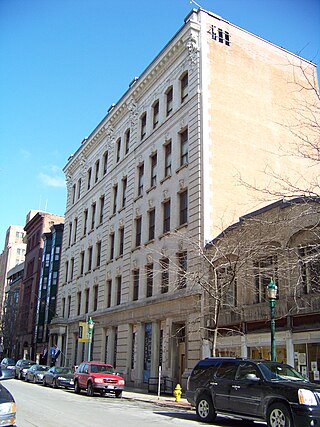Related Research Articles

Washington Crossing State Park is a 3,575-acre (14 km2) New Jersey state park that is part of Washington's Crossing, a U.S. National Historic Landmark area. It is located in the Washington Crossing and Titusville sections of Hopewell Township in Mercer County, north of Trenton along the Delaware River. The park is operated and maintained by the New Jersey Division of Parks and Forestry. It is supported by the Washington Crossing Park Association, a friends group that works to preserve, enhance, and advocate for the park.

The Allegheny Portage Railroad was the first railroad constructed through the Allegheny Mountains in central Pennsylvania. It operated from 1834 to 1854 as the first transportation infrastructure through the gaps of the Allegheny that connected the midwest to the eastern seaboard across the barrier range of the Allegheny Front. Approximately 36 miles (58 km) long overall, both ends connected to the Pennsylvania Canal, and the system was primarily used as a portage railway, hauling river boats and barges over the divide between the Ohio and the Susquehanna Rivers. Today, the remains of the railroad are preserved within the Allegheny Portage Railroad National Historic Site operated by the National Park Service.

The Delaware and Hudson Canal was the first venture of the Delaware and Hudson Canal Company, which would later build the Delaware and Hudson Railway. Between 1828 and 1899, the canal's barges carried anthracite coal from the mines of northeastern Pennsylvania to the Hudson River and thence to market in New York City.

The John Muir National Historic Site is located in the San Francisco Bay Area, in Martinez, Contra Costa County, California. It preserves the 14-room Italianate Victorian mansion where the naturalist and writer John Muir lived, as well as a nearby 325-acre tract of native oak woodlands and grasslands historically owned by the Muir family. The main site is on the edge of town, in the shadow of State Route 4, also known as the "John Muir Parkway."

A historic site or heritage site is an official location where pieces of political, military, cultural, or social history have been preserved due to their cultural heritage value. Historic sites are usually protected by law, and many have been recognized with official historic status. A historic site may be any building, landscape, site or structure that is of local, regional, national, or global significance. Usually this also means the site must be at least 50 years or older.

Buildings, sites, districts, and objects in New York listed on the National Register of Historic Places:

The Mabee House, on the grounds of the Mabee Farm Historic Site,, is the oldest house still standing in the Mohawk Valley. It is located in the town of Rotterdam, New York, in the hamlet of Rotterdam Junction, New York, along New York State Highway 5S, about six miles (9.7 km) west of the city of Schenectady.

Delaware & Lehigh Canal National and State Heritage Corridor (DLNHC) is a 165-mile (266 km) National Heritage Area in eastern Pennsylvania in the United States. It stretches from north to south, across five counties and over one hundred municipalities. It follows the historic routes of the Lehigh and Susquehanna Railroad, Lehigh Valley Railroad, the Lehigh Navigation, Lehigh Canal, and the Delaware Canal, from Bristol northeast of Philadelphia to Wilkes-Barre in the northeastern part of the state.

Schoharie Crossing State Historic Site, also known as Erie Canal National Historic Landmark, is a historic district that includes the ruins of the Erie Canal aqueduct over Schoharie Creek, and a 3.5-mile (5.6 km) long part of the Erie Canal, in the towns of Glen and Florida within Montgomery County, New York. It was the first part of the old canal to be designated a National Historic Landmark, prior to the designation of the entire New York State Barge Canal as an NHL in 2017.

Save America's Treasures is a United States federal government initiative to preserve and protect historic buildings, arts, and published works. It is a public–private partnership between the U.S. National Park Service and the National Trust for Historic Preservation. The National Endowment for the Arts, National Endowment for the Humanities, and Institute of Museum and Library Services are also partners in the work. In the early years of the program, Heritage Preservation and the National Park Foundation were also involved.

The New Harmony Historic District is a National Historic Landmark District in New Harmony, Indiana. It received its landmark designation in 1965, and was placed on the National Register of Historic Places in 1966, with a boundary increase in 2000. The district includes properties within the Historic New Harmony State Historic Site. Twelve buildings from the early 19th century and twenty from the mid-19th century are within the district. The original boundary was Main Street between Granary and Church Streets and was later increased to include the area bounded by North and Steam Mill Streets and between Third and Arthur Streets.

The Georgia State Railroad Museum is a museum in Savannah, Georgia located at a historic Central of Georgia Railway site. It includes parts of the Central of Georgia Railway: Savannah Shops and Terminal Facilities National Historic Landmark District. The complex is considered the most complete antebellum railroad complex in the United States. The museum, located at 655 Louisville Road, is part of a historic district included in the National Register of Historic Places.

This house was originally built on South Street in Oyster Bay, New York, around 1720, as a small one-room dwelling. During the 19th century two successive Baptist ministers made their home here. The house was later moved from its location on South Street to 20 Summit Street. In 1966 the house was donated to the Town of Oyster Bay, for the use of the Oyster Bay Historical Society. The society operates the house as a museum, with two rooms interpreting the periods 1740 and 1830. Inside you can see how an 18th-century tradesman might have lived, then you can see how Rev. Earle entertained his 19th century guests in the parlor. An authentic recreation of an 18th-century garden is on the grounds behind the house. Today the house is a Town of Oyster Bay Landmark and a featured site on the Oyster Bay History Walk audio walking tour.

The Historical Society of Baltimore County (HSBC) was founded in 1959 with the goal of preserving, interpreting, and illustrating the history of Baltimore County for the benefit of present and future generations of Marylanders, and is a resource for those interested in researching both local and family history. As the HSBC describes it, they "continually accomplish" their mission "through the production of presentations, lectures, workshops, entertaining educational publications, historical tours, and exhibits." Centrally located in Cockeysville, Maryland, the Society operates out of the Agriculture Building, the former Baltimore County Almshouse, which was built in 1872 and used to house the poor and mentally ill of Baltimore County until 1958.
Historic Palmyra
Founded in 1916, the Columbia County Historical Society and CCHS Museum & Library collects, preserves, interprets, and presents the history, heritage, and culture of Columbia County, New York, and serves residents of all eighteen Columbia County towns and the city of Hudson.

The Onondaga Historical Association (OHA) is a private nonprofit entity that operates as a research center on the history of Onondaga County, with museums, educational centers, retail operations, and exhibits at multiple locations throughout Onondaga County. Founded in 1862, OHA's mission is to preserve the history of Central New York and encourage the Onondaga County community to appreciate and utilize its history.
References
- ↑ "Revenue-draining canal should be cut from Thruway". Utica (New York) Observer-Dispatch, January 9, 2008. Archived February 8, 2013, at archive.today Retrieved 2011-04-12.
- ↑ New York State Historical Association (November 9, 2006), Internal Revenue Service Form 990 (Return of Organization Exempt From Income Tax: New York State Historical Society, Fiscal year ending June 30, 2005) (PDF), Guidestar.org
- ↑ American Irish Historical Society Retrieved 2011-04-12.
- ↑ Brooklyn Historical Society official website Retrieved 2011-04-12.
- ↑ The Brooklyn Historical Society (March 31, 2007), Internal Revenue Service Form 990 (Return of Organization Exempt From Income Tax: The Brooklyn Historical Society, Fiscal year ending June 30, 2006 (PDF), Guidestar.org
- ↑ Bronx County Historical Association (May 14, 2007), Internal Revenue Service Form 990 (Return of Organization Exempt From Income Tax: Bronx County Historical Society, Fiscal year ending June 30, 2006 (PDF), Guidestar.org
- ↑ Canal Society of New York State Retrieved 2011-04-13.
- ↑ Preservation Association of Central New York Retrieved 2011-04-13.
- ↑ Clinton Historical Society, Clinton, Oneida County Archived 2008-02-16 at the Wayback Machine Retrieved 2011-04-12.
- ↑ Herkimer County Historical Society Retrieved 2011-04-13.
- ↑ Manlius Historical Society Retrieved 2011-04-13.
- ↑ Marcellus Historical Society Archived 2008-02-10 at the Wayback Machine Retrieved 2011-04-13.
- ↑ Oneida County Historical Society Retrieved 2011-04-13.
- ↑ Onondaga Historical Association Archived 2008-05-14 at the Wayback Machine Retrieved 2011-04-13.
- ↑ "Officers of the Oswego Town Historical Society". Archived from the original on 2009-04-15. Retrieved 2011-04-13.
- ↑ Town of Pompey Historical Society Retrieved 2011-04-13.
- ↑ Schoharie County Historical Society Retrieved 2011-04-13.
- ↑ Skaneateles Historical Society Retrieved 2011-04-13.
- ↑ Solvay-Geddes Historical Society Retrieved 2011-04-13.
- ↑ Spafford Area Historical Society Archived 2008-05-14 at the Wayback Machine Retrieved 2011-04-13.
- ↑ Tully Area Historical Society Retrieved 2011-04-12.
- ↑ White Plains Historical Society Retrieved 2011-04-13.
- ↑ New York History Net listing. Retrieved 2011-04-12.
- ↑ Elbridge Village History Archived 2008-01-06 at the Wayback Machine Retrieved 2011-04-13.
- ↑ Village of North Syracuse history Archived 2008-05-12 at the Wayback Machine Retrieved 2011-04-13.
- ↑ Onondaga County Sheriff's Office history Retrieved 2011-04-13.
- ↑ "Home - Erie Canal Museum". eriecanalmuseum.org. Retrieved 2023-10-27.
- ↑ Landmark Theatre Retrieved 2011-04-13.
- ↑ German Immigrant Ancestors in Syracuse and Onondaga County, New York Retrieved 2011-04-13.